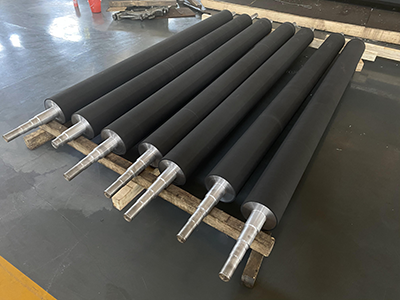Rubber Roller Construction
Cores can be as simple as a tube with installed bearings in each end mounted on a shaft, or as complete as a fully constructed body, with welded end plates and shaft (or journal). Bearings can be fitted on each journal end to allow for free rotation, or have an extended shaft with a key to allow the roller to be driven by the process. This can be further broken down into several parts.
Shaft: The shaft is the machine part that connects the whole roller to the motor, sprocket, or other drive units. It is typically solid in construction with high strength and uniform hardness. The shaft is designed to endure bending and torsional stresses. Bending stresses are caused by the radial forces against the roller; while torsional stresses are from the torque generated by rotating the roller to tangentially move loads. The shaft can be coupled to the drive unit by means of a key and keyway, or by set screws or machined flats, or in the case of a free spinning roller, the bearings are mounted in some type of housing or pillow block fixture.
Cylinder: The cylinder is a hollow part typically in the form of a pipe or tube. This is where the rubber lining is wrapped and bonded. The metal has sufficient thickness to resist deflection upon application of load. The cylinder is usually made from steel, though other rigid but light materials can be used such as aluminum and reinforced plastics. The ends of the cylinder are typically machined to either receive pressure in bearings or a metal flange (end plate).
Flange: The flange or end plate connects the cylinder onto the shaft. The shaft, cylinder, and flange are held together by welds.
Bearings: Bearings are used to reduce friction against the static and rotating parts. The configuration, mounting, and type of bearing can vary depending on the design of the roller. The configuration described previously has the shaft installed together with the roller cylinder. In other designs, the bearing can be installed on the roller while the shaft is static on the main equipment.
Rubber Cover: The rubber lining is the outer cover that comes into contact with the load or process material. This part takes the most wear and tear with the intention of protecting the roller core and the surface of the load. The type of rubber material and grade are based on the roller application. Summarized below are the types of rubber that are recommended for providing a specific property, though all are formula specific..
- Hardness: SBR and FKM for high hardness (Shore A 60 to 95); NBR and PUR for a wider range (Shore A 10 to 95)
- Abrasion Resistance: SBR, PUR, XNBR, HNBR, CSM
- Tear Strength: SBR, PUR, XNBR, HNBR, CSM
- Compression Set: NBR, CR, Silicone, PUR
- Thermal Resistance: SBR, EPDM, Silicone, FKM, CSM
- Low-Temperature Toughness: NBR, CR, EPDM, Silicone
- Aging Resistance: Butyl, CR, EPDM, Silicone
- Acid and Alkali Resistance: Halogenated Butyl, EPDM, CSM
- Water Resistance: Halogenated Butyl, Silicone, EPDM, CSM
- Oil Resistance: NBR, CR, FKM
- Solvent Resistance: NBR for petroleum-based solvents; CR, EPDM, Silicone, and Butyl for alcohol-based solvents; CR, EPDM, CSM, and Butyl for ketone and ester-based solvents.

EPDM rubber transport rolls
Articles You May be Interested in
Applications of polyurethane rubber
How to do Anilox Roller Cleaning to Print Good Products?
Conveyor Roller Design: How to Create a Better, More Efficient Roller







